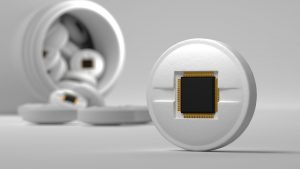In the future, with technological advances outpacing even the most ambitious predictions, and simple everyday conveniences quickly being replaced by modern machinery, science fiction authors and futurists can be seen as forecasters of tomorrow.
Even the most fantastic of literary inventions seem quite possible given the breakthroughs of recent years.
The reality is that science fiction has, for decades, been predicting, and in some cases, informing real-life advances, often in ways that most people don’t realize.
In 2011, Dennis Cheatham, a Miami University professor and design researcher, drafted an academic paper entitled “The Power of Science Fiction: Exploring Sci-Fi’s Relationship to Real-World Innovation,” in which he cites such authors as H.G. Wells, who famously wrote in 1914 about the discovery of atomic energy and the advent of the first nuclear bomb, two events that didn’t happen for decades.
Cheatham’s thesis isn’t that Wells influenced scientists who would later discover and harness atomic energy, but that science fiction, as a rule, forward-thinks to the future, imagining the what-ifs that might someday come to be.
5 Medical Inventions Inspired by Science Fiction
Whether or not there’s any correlation between real-life creations and their fictional iterations may simply be up to the individual to decide. But there are at least five modern-day medical technologies that seem to have been foreshadowed by science fiction writers.
The Tricoder (Inspired by the Scanadu Scout in Star Trek)
The Scanadu Scout is a small disk that you can hold between your thumb and forefinger. Embedded with scanners, the Scanadu Scout instantly begins registering physiological information as soon as you place the device to your forehead. Designed by Yves Behar, the lightweight, portable device represents a major breakthrough in self-diagnosis, data mining and ehealth technology.
If the idea itself seems familiar, well, you might be a Trekkie. Fans of Star Trek would say the Scanadu Scout is nothing more than a Tricorder, the hand-held scanners used by crew members of the Starship Enterprise. In “Star Trek” lore, there were three Tricorders designed for specific science, medical and security needs.
3D Printers for Organs (Inspired by the Replicator in Star Trek)
In 2014, Organovo, a California biotech firm, took the capabilities of three-dimensional printing to an entirely new level by announcing its intention to begin selling 3D-printed liver tissue to allow for medical research on non-human organs. At the same time, the company’s executive vice president predicted that in just a few years, such 3D tissue could be introduced into a human patient to encourage cell regeneration or replace small portions of existing tissue.
Once again, diehard Star Trek fans will recognize the inspiration – the Replicator, which took the technology of a transporter and utilized it to dematerialize and then rematerialize matter in another form. The technology was used in the Star Trek universe for everything from food to machinery to clothing.
Embryonic Genetic Modifications (Inspired by Gattaca)
One of the most ingenious, and little-recognized, science fiction films of the 1990s was Gattaca, which when released in 1997 foretold a future where children could be genetically manipulated to guarantee they received the best hereditary traits of their parents. The film is both thrilling in its depiction of future society and cautionary in its exploration of the genetic discrimination that might result.
In June 2014, National Public Radio published a story on its website detailing a new medical procedure that could prevent mitochondrial disease by utilizing DNA from three people, two women and a man, to create a single healthy embryo. The procedure, according to a British health agency, might be a reality by 2016. According to the United Mitochondrial Disease Foundation, as many as 4,000 children are born in the U.S. each year with the disease which can affect the brain, vision, hearing and internal organs.
Exosuits (Inspired by Various Films and Comics)
Science fiction writers have maintained a long fascination with enhancing humans with machine exoskeletons. There was Iron Man’s first comic book appearance in 1963, Ellen Ripley climbing inside a Power Loader to battle the Xenomorph Queen in 1986 “Aliens”, “RoboCop” in 1987 and even 2013 when South African director Neill Blomkamp affixed an external exoskeleton to actor Matt Damon in the sci-fi film, “Elysium”.
Fiction, it seems, is not much stranger than reality. The Food and Drug Administration in 2014 approved a robotic device called ReWalk to assist individuals with lower-body paralysis from a spinal cord injury. The motorized brace is fitted to support both legs and a portion of the upper body and uses motors to power movement at the hips, knees and ankles. ReWalk also includes a backpack with a computer and power supply. The use of the device would allow paralyzed individuals to sit, stand and walk with assistance.
Brain-Controlled Prosthetic Limbs (Inspired by Star Wars)
One of the most memorable reveals in movie history occurred in 1980’s Star Wars: The Empire Strikes Back when Luke Skywalker learned that Darth Vader was his father just moments after Vader severed Luke’s hand in a lightsaber duel. Skywalker eventually returned to battle after receiving a fully-functional bionic hand in “Star Wars: Return of the Jedi.”
In 2013, Gizmodo, an online science and technology website, reported on efforts by the Defense Advanced Research Projects Agency, or DARPA, and Case Western University to develop a nerve electrode system that would allow amputees affixed with a prosthetic hand to experience sensitivity to the touch. DARPA’s RE-NET program, short for Reliable Neural-Interface Technology, would work with a separate system designed by Case Western to focus on remaining nerves to encourage direct sensory feedback.
DARPA has been at the forefront of amputee technology, having launched its Revolutionizing Prosthetics program in 2006. According to the company’s website, the company has made significant advances in upper-limb technology, including studies to allow a subject to control an advanced prosthetic arm with his or her mind.
Health IT Professionals Shaping the Future of Medical Devices
These examples of technology merging with medical breakthroughs are just the beginning. Such innovations are causing employers to ramp up the search for health IT professionals to be prepared for the future.
With more data to analyze, organize and disseminate, a growing number of employers are looking for workers skilled in health informatics who might help bridge the gap between past practices and future possibilities.




